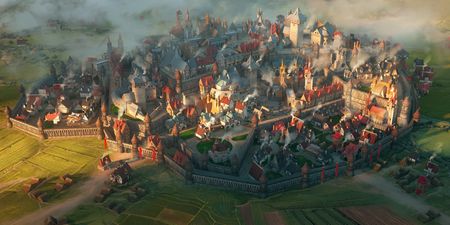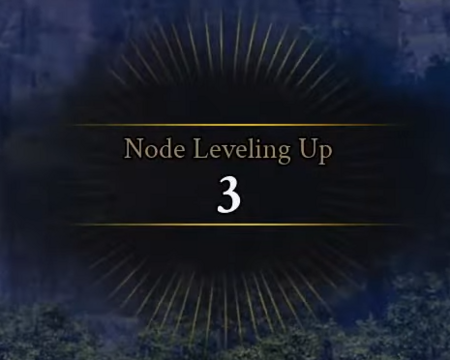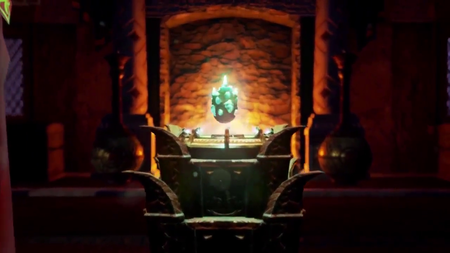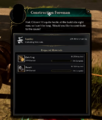Nodes
Nodes are a pre-set location, wrapped in a zone of influence, in our world that can form into towns of different sizes. These sizes range from a small camp to a sprawling metropolis. The size of the towns depends on the contribution by players and how far they’ve advanced the Node. Players do not create the footprint of a Node, but within that footprint they do have the ability to own land. Players who are part of the government for a specific Node will have the ability to modify building types and services further, but for the most part, a Node will grow along its own specific path (think about this more as NPCs building these towns out, rather than PCs individually putting buildings and walls up). A Node’s contribution area is larger than the actual town itself, allowing for players to adventure while building upon the town. We call the contribution area the Node’s “Zone of Influence,” and it’s the area where players help to advance the Node they are in.[2]
Encompassing each server are carefully placed points of development called Nodes.[3] There will be 85 regular node locations at launch with 15 additional castle nodes (5 castles x 3 castle nodes each)[4][5][6] for a total of 100 nodes.[7]
- Previously the developers estimated 103 regular node locations with 15 additional castle nodes for a total of 118 nodes.[8][9][4][5][6]
- This decrease in node count does not affect the amount of available player housing, or the estimated server capacity.[10][11]
- We have moved from a 103 nodes to 85 nodes; and there's a few reasons for that. One, when we were doing the calculations behind how- in Alpha 2 and in the game- we want these vassal structures to exist, we had more nodes than what felt meaningful and we wanted to condense some of that those curated story arcs and hooks into the environment and realm around the areas to be more bountiful at a lesser node value: meaning bringing down the node count so that we can increase the richness of each of those nodes more than what was at 103.[7] – Steven Sharif
- There were 9 node locations in Alpha-1.[12]
- Node locations are subject to change prior to Beta-1.[12]
- Nodes have emblems that can be placed on flags and certain types of armor.[13][14]
- Nodes are the heart of the world, they create the ebb and flow of life. At their core, Nodes are pre-set points in the world, wrapped in a Zone of Influence and surrounded by geographic areas that change over time based upon player participation. The world map is divided into regions, with each region containing multiple Nodes. As a Node advances, it influences the types of content within itself and the surrounding areas. Players do not create Nodes, but if they are a part of the government for a specific Node, they have the ability to influence diplomacy, and modify building types/construction and services within that Node.[8] – Margaret Krohn
Node types

Nodes exist all throughout the world and the location of said node will determine its type; but this type will be... seen at the first stage of development when the first stage when a node propagates real-time assets in the world; is basically these NPCs, these merchants that come into an area and they offer services and/or of stores or whatever the deal may be. You will see the flavor of the node from those merchants. So if it's a military node you'll see military people. If it's... an economic node you'll see merchants. If it's a scientific one you'll see scholars; and if it's a divine one you'll see priests and clerics. So players will have a very firm understanding of which node is which type in order to know how they want to progress.[16] – Steven Sharif
Nodes are assigned one of four (4) node types, each of which contain unique specializations.[8]
- Players will be able to identify the type of a node at its first stage of development (Expedition) based on its NPC population.[16]
| Node type.[8] | Specialization.[8] | NPCs.[8] | Currency.[17][18] |
|---|---|---|---|
| Divine nodes | Faith and skill/equipment augment focuses | Priests | Favor |
| Economic nodes | Trade and merchant focuses | Merchants | - |
| Military nodes | Combat and class training focuses | Guards | Honor |
| Academic nodes | Artisan and construction focuses | Scholars | - |
Ashes of Creation allows you, the player, to decide the fate of the world around you. With each Node Type, you can change the flow of resources and goods in the world. Will you grow the largest Economic Metropolis and help guide the riches of Verra, or will you choose another path unlocking new stories filled with allies and enemies?[19]
Node types are predetermined and are the same across all servers.[8]
- A node’s type is static. It does not change based on the node’s advancement or destruction.[8]
For example, if a level 4 Scientific Node is destroyed, it will become a Level 0 Scientific Node. It will never be any other Node Type other than a Scientific Node. The location of these Types relates to the influences of the area around the Node.[8] – Margaret Krohn
Node types affect various services and systems at each level of node advancement.[8]
- Node governments
- Narrative
- NPCs
- Node buildings and amenities
Node types will be definitive during the Beta testing stages.[20]
Beta testing will require that the node types be definitive; and that's because of how node types are integrated into the relating and corresponding neighboring points of interest and those quest lines. So it's not something we can swap very easily.[20] – Steven Sharif
Node benefits
Each node type has a superpower (ultimate ability) that becomes unlocked when the node reaches Metropolis (stage 6).[19]
Divine node benefits
Divine nodes at Metropolis (stage 6) may unlock a procedurally built "mega catacomb" dungeon beneath it that connects to its divine vassal nodes. These may house unique bosses with unique drop tables.[22]
Economic node benefits
Economic nodes that have reached the metropolis stage unlock the linked economy superpower. Economic nodes with this superpower share their Auction house listings with all others.[19]
- Up to two economic metropolises may be linked in this manner.[23]
- Metropolis level economic nodes enable worldwide sale prices for auction houses across Verra.[19]
- Items listed in one linked economic node can be bid on from any other linked economic node.[19]
- Linked economies also connect the economic metropolis and its vassal economic nodes.[19]
Economic Nodes that have reached the Metropolis Stage unlock the Superpower “Linked Economy”. Any Economic Node with this Superpower unlocked shares Auction House listings with all the others, meaning that the items listed in one Linked Economy Node can be bid on from any other Linked Economy Node. Linked Economies also connect a Metropolis and any Vassal Economic Nodes belonging to that Metropolis.[19]
The Linked Economy Superpower has the potential to create a massive market that spans the world. This will allow players to attain and sell goods with ease, providing those who have access to these Economic Nodes a faster path to fortune in the lands of Ashes of Creation.[19]
Military node benefits
Military nodes enable Bounty hunters and (potentially) reduced duration of corruption.[24][25]
Academic node benefits
Academic nodes that have reached Metropolis (stage 6) unlock teleportation within their vassal network, which can extend across seas, and also include islands.[26][15][27]
- If there are multiple scientific metropolises, then an airship will provide faster travel between those scientific metropolises for citizens of those nodes and their vassal nodes, so long as the metropolises are not at war.[28]
- Previously this was stated to be limited to citizens of metropolis academic nodes regardless of the stage of the vassal node, so long as the vassal node is not at war.[28]
- This will allow Citizens and Vassals of Scientific Metropolises to do things more quickly than others, as fast travel is limited in the world of Ashes of Creation. They’ll be able to exchange goods and information with ease and get to locations in the world at a quicker speed in order to gather crafting materials to create recipes, as well as participate in limited-time events.[28]
Node citizenship
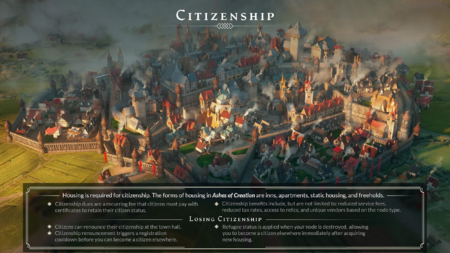
Citizenship is, aside from nodes existing, one of the most important parts. So you as a player will get to become a citizen of these nodes: you're going to need to acquire some form of housing to be able to do that within that node's jurisdiction, it's zone of influence.[30] – Chris Justo
Player housing grants the ability to claim citizenship of a Village (stage 3) node or higher.[29][30][31][32][24] Gaining citizenship through player housing is not automatic. It must be claimed.[31]
- There is not a hard cap to node citizenship, but there is a soft cap. Citizens pay dues and property taxes based on the stage of the node when the player became a citizen.[29][30][31][33][34]
- When you become a citizen you enter in at a certain citizenship due structure; and citizens pay taxes to their node in the form of both property taxes based on what type housing as well as citizenship dues, which are necessary. And as you enter later into the stage of a node's development, you will pay a higher value on the citizenship dues or vice-versa: if you own a property later, you will be entered into a property tax that is higher based on where you enter that property ownership within the node's history. So those help to form a soft cap. Now, if payers are willing to pay more to be a citizen of a particular node, they have that option, but at some point it becomes restrictive.[34]
- You can declare citizenship to only one node and when you declare that citizenship. Let's say for example, one guild perhaps wanting to take all their members and have them all declare the same citizenship to a location. The longer a node exists the higher the prize it is to take and some systems with regards to crafting progression and/or rewards and bonuses or the reliquary that we haven't really touched on a lot, those systems are going to be so enticing that from an incentive standpoint it will compel other groups to either potentially break alliances or siege the city in order to take the goods that are potentially in it. So, from an incentive standpoint we have that at play. Additionally, we don't have a cap per-se that we've announced yet on the citizenship aspect of being in a node, but we do have soft caps. It becomes costlier the higher number of citizens each time one new person wants to join to be part of a node. So, there is sort of a soft cap on how many citizens one node can have and it might be that not all in the guild can participate in that area. So, there's a natural divide: A pseudo faction, so to speak between who is a part of that node and who is not.[34] – Steven Sharif
- Your account is bound to one declared citizenship per server, which means that if you have two alts and your main character on one server you may only be a citizen of one node between those three... If you have an alt on a different server, it could be a citizen of a node as well.[38] – Steven Sharif
- Players lose their node citizenship after their node is destroyed in a node siege without entering into a cooldown period.[39][36][40]
- Apart from node destruction, there is no player driven system that can strip another player of their node citizenship.[41]
- Node citizenship is not tied to membership of a guild. Guilds don't "own" nodes.[36]
- Players can interact with the node board to get a list of citizens of the node. Clicking on a citizen will reveal information about their guild, society, religion, and property ownership.[42]
- Citizenship tickets may also grant citizenship to certain node stages. This mechanic will be decided based on testing.[43]
- A player does not need to declare citizenship of any node. These players won't need to pay taxes but will miss out on benefits of citizenship.[44]
Citizenship benefits
Node citizenship grants a number of benefits.[24]
- Reduced fees for node services.[29][30]
- Reduced tax rates.[29][30]
- Access to the node's reliquary.[29][30][45]
- Access to exclusive unique vendors based on the node's type.[29][30]
- Access to merchants that offer specific types of enhancement stones or stat migrations.[45]
- For example there may be merchant tables that only citizens have access to. Those merchant tables might relate to specific types of enhancement stones or specific type of stat migration abilities. You might have access to mundane crafting benches but the upper-tier crafting benches are for citizens. Citizens only have access to the reliquary and the achievements that the node has from its citizens nearby areas and content like raid bosses that they might kill. They may have a weekly allotment of what specific type of core material they can access from the reliquary and only citizens can do that... You might have access to certain types of buffs that occur during like events; and only citizens can have access to those types of buffs. There are obviously going to be title structures within organizations, within religions and stuff that relate to these events and procedures that only citizens can be part of. That title structure for that specific node.[45] – Steven Sharif
- Access to limited functions and service buildings within the node.[45]
- Access to upper-tier crafting benches.[45]
- Access to buffs from certain events.[45]
- Access to titles.[45][24]
- Access to organizations and religions.[45]
- Participation in the node’s government (voting or running for office).[24]
- Other stated benefits include: Reputation, Honor, Loyalty, Merit.[24]
Non-citizens will have access to generic node services, mundane crafting benches, and standard rewards from node quests.[45]
- There are limited functions and services that non-citizens can gain access to as a result. Obviously you want to attract traffic. You want to attract commerce. You want to track taxation. That's possible because those are the means by which the node continues to grow; and in order for that to be attractive you must offer it to non-citizens alike... We don't want to necessarily be super lockout on content per-se, so most quest-lines are still going to be accessible from non-citizens and citizens alike, however the reward tables for those quests might be higher for citizens. You may have additional rewards that be granted based on quest completion and progression.[45] – Steven Sharif
Zone of influence
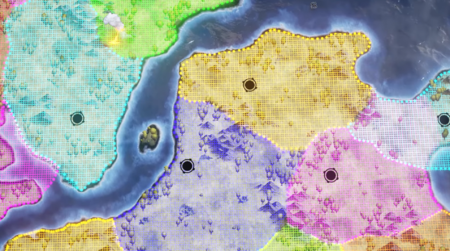
Every Node is given purview over a predefined geographic area called a Zone of Influence (ZoI). No matter where you go in the world, whether you’re questing, gathering, or raiding, you’ll be helping determine which nodes will develop, and what Zones of Influence will expand. Any area that a Node controls is considered its Zone of Influence, including Vassal Nodes, and all Vassal Nodes exist within the Zone of Influence of their Parent Node.[8] – Margaret Krohn
Every node is given purview over a predefined geographic area called a Zone of influence (ZOI). Player activity within the ZOI is weighted and counted toward a particular node’s advancement.[2]
The main thing that differentiates us from other MMOs is that we have a living, breathing, reactive world... Our world is separated into zones, which are then separated into what we call nodes. Nodes are sort of invisible zones of influence that listen to everything that a player does; so as players gain experience from killing things, gain experience from doing quests, gain experience through crafting things, the node is also gaining that experience. Once a node gains enough experience it levels up and then starts to attract NPCs to it .[46] – Jeffrey Bard
- By undertaking familiar activities, such as questing, gathering and raiding, players have agency in determining which nodes in the world will develop.[47]
Each Node can form into towns, but are limited by their neighbors. The Nodes have different levels of advancement. There can only be so many of each level. Think of this as advanced settlements needing more elbow room. Nodes encompass more land as they grow and will require more effort to be sustained. This system is a main driver for change in the world because it creates scarcity. As Nodes advance in stages of growth they will lock out neighboring Nodes from progressing, and will absorb their zones of influence.[2]
- Zones of influence connect fully across the world without any gaps.[48]
There is not a space where you will move in to do something and no node will get that experience.[48] – Steven Sharif
- Underrealm nodes and nodes directly above them are considered adjacent but do not exist in the same ZOI.[49][50][51]
- Up to one fifth of the world will be encompassed within the ZOI of a Metropolis. The many vassal nodes within a ZOI's "border" could end up looking like a country or nation.[52]
Node simulation
This representation does show 111 nodes as part of this particular simulation. I'm not sure what the tick frequency is on this video. It might be something on the magnitude of like every second is probably 12 to 24 hours. So over time you start seeing these larger node systems building up to eventually where you might see Cities and Metropolises after some period of time; and what this allows the design team to do from a tools perspective, as they simulate this idea of how the world is going to progress, is it gives an opportunity to see strange happenings or something that we couldn't necessarily predict but was a possible outcome based on the variables present.[53] – Steven Sharif
The developers have created a simulation of node interactions in preparation for Alpha-2 deployment of the node system.[53]
- This simulates how nodes advance and expand their zones of influence over surrounding nodes.[53]
You can show the initial territories on the Verran map of what these particular nodes have governance over, or their Zones of Influence as we like to call them... As the simulation of this begins to advance and nodes begin to expand their territory and they begin to take over nearby nodes as a result of their of their growth, you start to see these power level ratings that are applied here on specific nodes that determines what type of takeover power it has and and what it pushes back against for other nodes that are looking to take over new territory as they advance.[53] – Steven Sharif
- It also simulates events, such as NPCs attacking and disabling certain node buildings and services. Failure to successfully respond to these will reduce the node's "health ticker", which will slow down the XP gains from the node.[53]
It also simulates events: So each of these nodes will have a health ticker: when that health ticker is impacted it'll stop gaining power or gaining or slow down in its gaining of experience; and that's because certain events can affect a node by disabling certain services, disabling buildings. Players don't respond to that horde of zombies that have come out of the nearby ravine then those zombies can attack stables, they can attack service buildings, and prevent particular types of quests or activities and services from happening until it's repaired.[53] – Steven Sharif
- Node sieges are simulated, with successful sieges destroying the nodes, and where unsuccessful sieges won't destroy the node but may result in disabled buildings or services, similar to events.[53]
It simulates the sieges if a particular node has a certain frequency that's set where we want to see randomization of how nodes get affected by sieges. Sometimes they'll be destroyed in the simulation. Sometimes they'll have disabled services again, similar to an event, because they didn't succeed necessarily at sieging the node but they did succeed at disabling some of the buildings as part of that siege.[53] – Steven Sharif
- It simulates what outcomes may happen in the live game as a result of player activity, such as splitting up a particular ZOI across a waterway, or having territories expand out to islands or across continents.[53]
It simulates what players could potentially do as well when the game goes live; and that might include things like splitting up a particular Zone of Influence across a waterway, having your territory expand out to an island, or across continents. These are these are the types of things that we want to see players do eventually obviously but this tool provides the design team the opportunity to see it repetitively and over a fast period of time so they see these different types of outcomes.[53] – Steven Sharif
List of nodes
Node stages
Nodes advance by collecting experience from the actions of players nearby. As players complete content inside of a Node’s Zone of Influence (the area around the node), they contribute that experience toward the Node’s development. The experience given to the Node may then be modified based on certain Events and Accomplishments. When a Node reaches the experience required, it undergoes the process of advancing to the next stage. There are a few exceptions where a Node cannot advance even though it has the required experience - most commonly, a Node can not advance if a Node is a Vassal of another Node and would advance to the same stage as its Parent Node.[40] – Margaret Krohn
Nodes have seven (7) stages of advancement, with experience thresholds for each stage. When a Node reaches the experience required for its current stage, it advances to the next stage.[8]
| Node stage.[3] | Symbol | Alternate name.[54] | Timeframe to advance.[3] | Player housing.[55] | |
|---|---|---|---|---|---|
| 0. | Wilderness | - | |||
| 1. | Expedition | Crossroads | Few hours | - | |
| 2. | Encampment | Camp | Many hours | - | |
| 3. | Village | - | Few days | Small houses | |
| 4. | Town | - | Many days | Medium houses | |
| 5. | City | - | Few weeks | Large houses | |
| 6. | Metropolis | Metro | Many weeks | Mansions |
Node advancement
Citizen and non-citizen player activity (questing, gathering, raiding, etc.) within a node's ZOI counts toward that particular node's advancement (progression) to a higher node stage.[40][3]
The advancement of a node unlocks its unique content, which comes at the cost of locking out an increasing ring of neighboring nodes from progressing to the next stage.[57]
- Nodes advance to the first stage quickly. This enables NPC services such as vending or banking items.[58]
- The more advanced the node is, the larger its ZOI becomes.[15]
- Less advanced nodes (referred to as vassal nodes) that fall within a more advanced node's ZOI can still gain XP, but must remain at a lower advancement stage than the dominant node.[59]
- The vassal system begins when a node hits Village (stage 3), but neighboring nodes starting from Expedition (stage 1) also block the growth of their immediate neighbors.[60][61]
- Certain quests, such as story arcs, may not be able to be turned in after a node has advanced.[62]
- The territory expansion algorithm takes into account the nearest coast, neighboring nodes, and the heatmap of players in surrounding areas over the last weeks or month.[63]
- Due to the way the progression algorithm calculates territorial (ZOI) expansion during node advancement, there is a small possibility that two nodes of the same stage end up being close to each other.[64]
- The way that the algorithm expands the territories takes into account a few things: One it takes into account the coast like where's the closest coast. Two it takes into account the neighboring nodes so it can take over and essentially vassal state those nodes, but what's more important is essentially the initial population based on like how players choose their races. Because we have nine different races and four different starting points that branch out, each server's population density is going to dictate essentially the first few nodes that are highly populated and then that initial seed is what's going to determine the node structure as it moves inland into the into the world essentially; and based on the performance and successes of different sieges will determine which nodes that got locked out from the previous the initial advancements what nodes can now be available to advance further. So I really think that with so many variables that are present in the equation of how nodes advance and stay existing with the more variables you have, the higher likelihood there is for there to be a significant diversion in world progression.[63] – Steven Sharif
- Normally the algorithm that's applied to the node territorial expansion will prevent significant nodes from being in close proximity to each other... There could be a perfect storm where all of the algorithmic progression of territory leads to having these nodes very close to each other because there's certain requirements that should that need to be available to satisfy node vassal takeovers; and it's possible that two nodes would never take each other over as vassals and end up close together and spanning their territories in opposite directions: The Tale of Two Cities thing.[64] – Steven Sharif
- A node does not receive XP from the nodes within its ZOI until these nodes have reached their cap.[59]
- Node experience gain opportunities will be equitable across the four node types.[66]
- Different people have different resources invested in nodes progressing and it would be a little "gamey" if you could know exactly what was necessary at that point because that would disincentivize people from participating.[67] – Steven Sharif
Node advancement spawns a series of animations and visual effects (within the footprint of the node).[68][40]
- Players within the node are teleported to a safe location, likely a respawn area near the node.[68][69]
- Supplies will spawn around the node and system driven caravans are spawned to bring these supplies into the node. These caravans are not able to be attacked.[68]
- NPCs will begin construction activities.[68]
- Players outside the node will see the new facade of the node pop into existence as the node advances in stage.[68]
- The Development Area of a Node is where civilization will appear as the Node advances. As the Node Stage increases, different buildings, NPCs, and services will become available in the Development Area. The higher the Node Stage, the more complex and populated the Development Area becomes. Development Areas will also vary depending on the Node Type - Economic, Military, Scientific, or Divine.[40] – Margaret Krohn
Vassal nodes
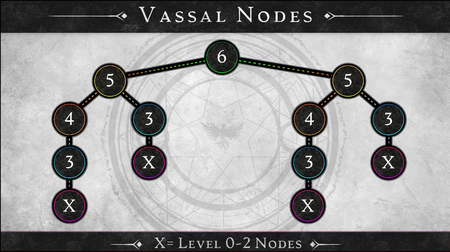
This vassal mode structure tells you what it looks like for a sovereign at a level six metropolis stage; and what it can control at a maximum vassal network is two level five nodes, of which a level five node can control one level four and one level three as direct vassals; and then the four can control a three; and every three can control a one or a two. Now if the three gets removed through siege, the one or the two is removed as well. So that's an important distinction between the three's vassals, which technically isn't really a vassal relationship because there's no citizenships possible. Those vassals don't exist between three and X, but they do exist between four and three, five and four, and six and five. And what this also allows is that because there are 85 nodes that are within the world, we have a buffer zone of about 20 nodes that lives in a max server state. So if you had maximum five metropolises form in a world, you will have a number about 20 nodes that can live alongside those metropolis networks; and when or if a metropolis falls, that extra cushion of nodes around the five metropolis structures allows for the map to be redistricted in a way that is unique. It doesn't mean that one of the fives is just going to pick up where the last six left off and form the same exact metropolis structure. From a territory perspective it has ancillary nodes to play with and expand towards that redistricts the map, so that if a metropolis falls there's a significant difference in the layout of the world and the layout of these almost nation-like territories.[70] – Steven Sharif
Village (stage 3) or higher nodes enslave nearby nodes, converting them into vassal nodes.[8][61]
- A Metropolis (stage 6) can control up to two City (stage 5) nodes. A City (stage 5) can control one Town (stage 4) and one Village (stage 3) node. A Village (stage 3) can control an Encampment (stage 2) or an Expedition (stage 1). If the Village (stage 3) gets destroyed through a siege, its dependant Encampment (stage 2) and Expedition (stage 1) nodes are also destroyed.[70]
- There is a layer of intricacy between how the neighboring nodes advance and what potential parent structure they have in the vassalship tree.[71] – Steven Sharif
- Vassal nodes gain benefits from their regent node (also referred to as sovereign node or parent node) even if the node type of the parent is different to the vassal.[72][73]
- It is not a bad thing to be vasseled, it is a good thing to be vasseled. It brings many benefits from the Sovereign, which is the ultimate parent of that vassal network down to the vassal node itself; and it allows that vassal node to even live outside of its normal mechanics. You get to adopt some of the benefits that the node type of your sovereign is, even if your node type as a vassal node isn't the same.[73] – Steven Sharif
- Regent nodes collect taxes from their vassal nodes. These taxes cannot be taken by the mayor or other players.[74]
- Vassal nodes must remain at least one node stage below their parent node.[8]
- Neighboring/Adjacent nodes from Expedition (stage 1) upward block the growth of their immediate neighbors. This was intended to be tested in Alpha-1.[60][61]
- Vassal nodes first apply any experience earned to their own deficit (see Node atrophy). It then applies excess experience earned to its parent node.[40]
- If the parent node advances, the vassal is once again able to advance.[8]
- Vassal nodes give excess experience to their parent node and may have their own vassals; so long as they fall within the parent node’s zone of influence.[74][8]
- If a node is capped and is both a vassal and has its own vassals, any experience earned from itself or its Vassals is first applied to its own deficit. Experience beyond that is then sent to its parent node.[40]
- When the vassal reaches its cap it overflows experience up to the parent; and so it can be very good early on for parents to get vassal nodes that are very productive- that have a lot of traffic.[74] – Steven Sharif
- Vassals are subject to the government, alliances, wars, taxes, and trade of their parent node, and are able to receive federal aid from them.[8]
- Vassal nodes cannot declare war on their parent node or any of their vassals.[8]
- Citizens of vassals are bound by the diplomatic states of the parent node.[8]
- If a Node is a Vassal Node and is capped from advancing further, it first applies any experience earned to its own deficit (see Node Atrophy section), and then applies excess experience earned to its Parent Node. If the Parent Node advances and the Vassal is able to grow, it becomes uncapped. If a Node is capped and is both a Vassal and has its own Vassals, any experience earned from itself or its Vassals is first applied to their own deficit. Any experience beyond that is then sent to its Parent Node.[40] – Margaret Krohn
Adjacent/Neighboring nodes
Adjacent nodes (Neighboring nodes) starting from Expedition (stage 1) may block (lockout) the growth of their immediate neighbors.[60][61]
- Vassal nodes must remain at least one node stage below their parent node.[8]
- Encampment (stage 2) and Expedition (stage 1) nodes are technically not vassal nodes as they do not support citizenships. If their parent Village (stage 3) node is destroyed by a node siege, these nodes are also destroyed.[70]
Zones and progression
Dungeons, Raids, World bosses, Mobs, Quests, Events, Resources, Narratives and other content within a node's ZOI will have a diverse level range; but will scale with the advancement of that node and its racial influence.[75][76][8]
- Portions of the spawn tables (for mobs and resources) are static and other portions are dynamic and adapt to node development.[77]
- We don’t have a strictly level 25 zone. Instead, that zone might have some level 10 creatures near the road, some level 20 creatures deep in the forest, and some level 30 creatures up the mountain. These ratios will change based on the Nodes that inform them, becoming generally more dangerous as the Node grows. All this civilization attracts the attention of Things-That-Should-Not-Be. This does not mean that wilderness areas are safe, by any means. Some may be safe-er, but all will have dangers that even the most experienced traveler needs to watch out for.[78] – Steven Sharif
World manager
The World manager is an algorithm in Ashes of Creation that controls dynamic world elements. It acts as both a throttle and an incentive system for various activities to ensure certain parameters are within acceptable thresholds.[79]
- A world manager is a technical term to define a server process that lives alongside the game server; and when the game server needs to do things- communicating with other game servers within that grid- it tells that manager and that manager sends it down to the appropriate server.[80] – Steven Sharif
- Prices of glint.[81]
- A heatmap of experience being gained to apply to node advancement.[81]
- The territory expansion algorithm takes into account the nearest coast, neighboring nodes, and the heatmap of players in surrounding areas over the last weeks or month.[63]
- Due to the way the progression algorithm calculates territorial (ZOI) expansion during node advancement, there is a small possibility that two nodes of the same stage end up being close to each other.[64]
- Transit of resources and goods between regions to drive quest rewards for nodes.[81]
- For example if you know iron is being used as a raw resource for a specific crafting path that might drive up the price of mithril or silver; and that will incentivize the market to course correct a little bit. The idea is to provide soft incentives that help to alleviate the demand and also to prop up the supply that might not be present from the economic systems.[81] – Steven Sharif
Node atrophy
Nodes accumulate an experience deficit each day based on the node's level, called node atrophy. The deficit is subtracted from any experience earned that day. If any deficit remains, then this is subtracted from the node’s experience pool.[40]
- An atrophy system may be implemented, where accumulated atrophy points will progressively disable services within a node. The node may be destroyed if a significant points threshold is reached.[64]
- There are intrinsic problems with reducing a nodes level as opposed to removing the node and it may be possible I'm just gonna say now that we don't actually atrophy nodes to delevel but rather accrue atrophy points that must be replenished over time; and if not it begins to disable services and further compound the atrophy problem; at which point when it reaches a certain atrophy point then the node would just disappear.[64] – Steven Sharif
Node governments
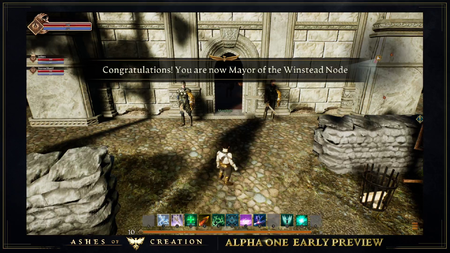
There are a number of different seats that can exist within a node, and carry different responsibilities.[83] – Steven Sharif
Positions within a node's government are attained through seasonal titles that grant special powers and benefits within the node.[84][83][85][24]
There are other node-based positions. Most of them relate to social organizational structures like the temple and the social organization building that the node might construct. Those are ladder systems of achievement that players can work through on a seasonal basis to achieve the highest level of that for the particular node; and by doing so they will then have titles bestowed upon them, which grants certain types of powers and benefits.[84] – Steven Sharif
- Mayors.[86]
- Priests, bishops, or acolytes of temples.[84][87][85]
- Social organization positions.[84]
- Patron guild leaders.[85]
- Chief bounty hunter.[85]
Mayors

Mayors have a unique ability to elicit change within the node proper, either through the destruction of certain buildings that have been constructed previously, because there's a limited number of slots that buildings can be constructed within, or the kickoff of additional projects, or the certain types of policies that can be enacted, like... the changing of a tax rate. They all have a unified source of energy requirement and the energy requirement is a mandate.[89] – Steven Sharif
Mayors are chosen through different election methods according to the node's type.[15][8]
- Only node citizens may be elected mayor.[37]
- Previous mayors won't have any special system driven bonuses to help them get reelected.[90]
- Kings and Queens can also become a mayors.[37]
- Mayoral leadership powers are granted via the use of mandates.[89][86]
- Players will be able to view a historical listing of mayors of a node.[91]
Node elections
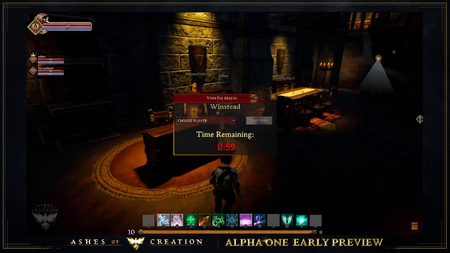
The village stage is a unique stage because that's when the government system comes online and all other stages past village there will have already been a cadence for the election system and it will follow that cadence, but after the initial village stage is completed there will be a one week period where players have an opportunity to establish citizenship at the village that also provides for the cooldown time that is- that would be present on players leaving another node to participate in in this particular node leveling up. But that after that one week period then there will be a one-week election process and then from that point moving forward will be the one month cadence that the node experiences elections on.[93] – Steven Sharif
Once a node has reached Village (stage 3) there will be a one week cooldown period before node elections begin.[93]
- This cooldown period allows players to establish citizenship at the village; which may require them to relinquish previous citizenship at another node.[93]
- Following the initial cooldown, there will be a one week election process, then from that point on, elections will follow a monthly cadence.[93]
- Node sieges may not be declared for 21 days following a node advancing to any stage.[94]
Node elections occur on a monthly basis.[93][96]
- Election notices will be mailed to the accounts of citizens.[42]
- Only citizens of a node may participate in its elections.[24]
- Only node citizens may be elected mayor.[37]
- A king or queen can also become a mayor.[37]
Leadership powers

The government has a lot of say in the direction of the node's development. Directing assets, building projects, tax allocation, defensive ability etc. Players have the ability to not only create these cities, but they have the right of self-governance.[24]
Mayoral leadership powers are granted to mayors via the use of mandates.[89][86]
- Initiate buy orders using gold from the node treasury.[29][97][98][99]
- Initiate mayoral commissions to aid node development.[29][100][98][89][101][24]
- Adjust node taxes.[29][89][102] This includes setting tax rates that apply to tavern games.[103][104]
- Tax money may only be used to fund node development.[105]
- Initiate service building construction and expansions.[29][89]
- Improving node defensive structures, such as stronger walls and gates, traps, and siege equipment.[101][106][107][108][24]
- Hiring mercenary NPCs to defend the node during sieges.[109][24]
- Set a message-of-the-day for the node.[110]
- Proposing node policies that are voted on by citizens.[111][112][101]
- Mayors won't have formal systems to carry out surveys/polls of node citizens, but they will be able to utilize node citizen chat or message-of-the-day services.[110]
- Mayors may have special color names in node chat channels.[110]
- Entering into trade agreements with other nodes.[29][111][113]
- Mayors cannot denote players as enemies of the state.[115] Previously this was a potential option.[113][116]
- Mayors are notified when their node is named on a siege declaration scroll.[117]
- Mayors and lords of castles have spells they can use on the battlefield with high effect and long cooldowns for their teams.[118]
- Mayors gain new powers and responsibilities as their node advances.[8]
- Some leadership powers are specific to node type, biome, or dominant race, others are universal.[120]
- There definitely are differences... Some of the things that mayors can do are more universal, but then some systems have very specific if your node has a certain dominant race, or your node is a certain type, or it's in a certain biome. So there's even differences between where it is too.[120] – Chris Justo
- If a mayor does not make certain decisions within a set period of time then the system will make a decision for them.[122][123]
- Q: The idea behind all these nodes are awesome, but I wonder how it will actually play out in the live version. The problem is having player run or the problem with having player run towns is that people come and go in video games. So, will towns die out etc?
- A: We incorporate as part of those designs certain fail-safes, certain protections, certain automated progression that takes over when some of those decisions are lacking or are not made; and those decisions can be defaulted. Now, of course, that would have a deleterious effect on the direction that a particular node might want to go, because they're going to be doing default behaviors, or default actions, as opposed to something that might be in line with the strategic objective of that particular node, or the specialization that the node has previously been attempting to do. But that is why we have a regularly recurring election period where players can take the reins of power and can elect someone else to come in and participate and and re-right the ship, so to speak. So it is absolutely a component of having player-driven mechanics that there is an opportunity for things to be less than ideal, or less than strategic when certain bad-faith actors or people leave, but there are safeguards in place.[122] – Steven Sharif
Node taxes
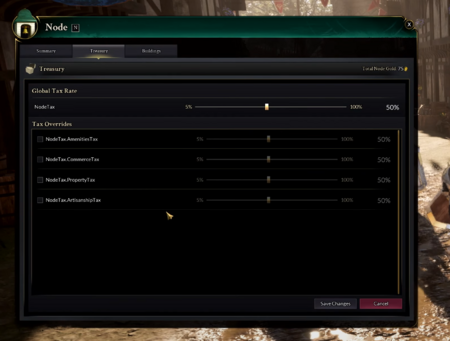
As the node levels up, you're gonna get access to deeper controls on the taxes, so that you as a Mayor can incentivize players to come to your node to do certain things. If you're a node that loves smithing, you're probably going to want to lower your taxes on artisanship to incentivize players to be here. But then you might want to drive up taxes on other avenues that players aren't necessarily coming to your node for, but are using out of convenience.[128] – Chris Justo
Mayors are able to set a generalized node tax rate as well as overrides for different activities within their node. Mayors gain additional taxation controls as their node advances.[128][102]
- Amenities tax override.[128]
- Artisanship tax override.[128]
- Commerce tax override.[128]
- This may include taxes that apply to tavern games.[103][104]
- Property tax override.[128]
- Freehold property taxes scale according to the number of freehold building permits issued for that freehold.[129][130][105]
- Citizenship dues and property taxes scale based on the stage of the node when a player became a citizen.[29][30][31][33][34]
- The goal is to exert financial pressure on node populations by making taxes increasingly expensive as nodes advance, rather than putting in place hard population caps.[31][33]
- Node tax rates will be visible on the world map by hovering over a node location.[131]
- Tax revenue only goes toward funding node development. This cannot be withdrawn by the mayor or any other player.[74][105]
Regent nodes take a cut of taxes from various activities that occur within their vassal node structure.[74][132]
- This tax doesn't necessarily impact the individual citizen, because citizen's tax levels are determined by their node, but the node's finances are affected by the taxation levied by its parent nodes.[132]
Node wars
Node governments may declare war on another node and rally citizens to the cause.[101][113]
- This mutually flags the citizens of the warring nodes, including their allies, as combatants.[133]
- Social organizations quests will either be cooperative or adversarial based on the war status of their parent nodes.[133]
- Vassal nodes cannot declare a node war on their parent node or any of their vassals.[8]
- Node wars can be declared at any time, but the objectives will only spawn during server prime-time.[134]
- Players can kill each other at any time during the war (not only during server prime-time).[134]
- Node wars affect reputation between the nodes.[29][111]
- We have conditions that you can set between nodes with regards to either nodes being friendly with each other and acting trade alliances, or they can declare war on nodes similar to how guild wars may function in different games, where those citizens become hostile to each other based on the player government that's elected in the particular node. So those systems all cater to allowing a conflict that's meaningful and that also provides a non-imbalanced relationship between stronger guilds and not as strong guilds.[34] – Steven Sharif
Internal conflict
There won't be a civil war mechanic within nodes but there will be scope for internal political conflicts; such as undermining the current leadership and disrupting trade.[135]
- The only way to remove an elected mayor prior to the end of their term is by destroying the node.[136]
We want consequences to matter and if that person got elected then you need to work within the means of the mechanics to get them unelected.[136] – Steven Sharif
Alliances
Ashes of Creation may have specific content that revolves around Alliances.[137]
- Progression pathways within alliances.[137]
- Guilds sharing common services with alliance members.[137]
- Node alliances.[138][137]
- Content that revolves around alliances specifically and progression within the development of that alliance; and the ability to share some common services between guilds that are part of that alliance. I think that additionally allowing alliances to toggle certain relationships with nodes as an interaction is beneficial. That's going to provide an interesting dynamic for players who are either members of the particular node that has the relationship established or members of the Alliance. So I think that obviously building systems is is about creating the channels by which these players can form bonds and the more layers you have around those channels of bonding between the different guilds or players, the more sustainable that relationship.[137] – Steven Sharif
Node quests
Commissions
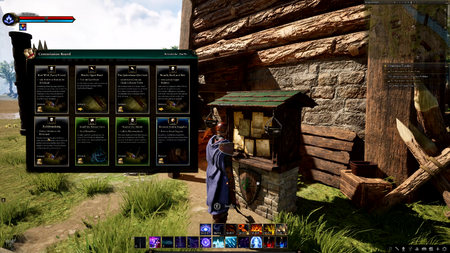
This is a commission board. Every mode has many different commission boards depending on what service buildings are installed there; and commissions are basically these teeny tiny little single objective quests that are like appetizers or quick little digestible things to help you get out into the world and start progressing both your character and your node contribution.[139] – Skott B
Commissions (previously called Tasks) are simple types of system-generated quests with singular objectives that enable characters and nodes to gain XP.[141][139][142][143][144][145][146][147]
- Commissions are posted on commission boards in nodes, which refresh approximately every 30 minutes (subject to change based on Alpha-2 testing). Everybody in the node can see and access the commissions relevant to their level and node reputation.[148][141][149][150][139]
- Everyone sees the same commissions relevant to their level range. Some commissions you see are more rare than others and will require sufficient reputation within the node in order to accept.[148] – Steven Sharif
- Commissions fall into categories based on node type, buildings constructed, social organizations, religions, and node policies.[151]
- Node commissions have dedicated commission slots that are categorized by such things as; node type, buildings constructed, social org, religion and policy.[151] – Steven Sharif
- Commissions are assigned rarities, which scale the rewards for their completion. More developed nodes will offer rarer commissions that are available to players with sufficient node reputation.[148][141][139]
- The rewards basically grow quite a lot depending on the rarity of the commission that gets dealt; and these get dealt for everybody... You can improve your chances of getting rare commissions for your node depending on how you develop your node.[139] – Skott B
- Commissions respond to (and can influence) different conditions in the world, such as weather, time of day, story arcs, and events. Commissions (along with other Node systems) attempt to lead players into areas where relevant content can be found.[149][150]
- Every 30 minutes or so the board will refresh. The server will query a bunch of different information about the world; and this is from ranging from story arcs that are active, story arcs that have been completed, weather, time of day- a whole bunch of different range of factors. The board will attempt to deliver commissions that are relevant to these areas and they will try to lead you into areas where more content can be found.[150] – Tyler Carroll
- Player characters may only have 20 active commissions at one time (subject to change based on Alpha-2 testing). This does not include other quest types, such as side quests, or story arc quests.[152]
- The types of commissions available in a node will be representative of the identity of that node, such as its social organizations, religious organizations, and node policies.[153]
- Q: Will commissions include tasks or quests that are reflective of the node type that they are issued in, or the nodes affiliation with a specific social organizations?
- A: Yes. The answer is yes. Nodes will reflect the theming that the node has and that theming can be influenced by things such as the identity of the node from a node type perspective, what social organizations, what religious organizations, even what policies the node has chosen to enact. Those will all be represented in the types of commissions that the node has to pull from; and so in that way you are solidifying the identity of that node; and again the dynamic state of the world that gets represented.[153] – Steven Sharif
- Commissions are similar to mayoral commissions but they are system-generated rather than initiated by Mayors.[144]
- Mayoral commissions are specifically chosen by the mayor, which is similar to the regular commission system, but that system is more system generated.[144] – Chris Justo
Mayoral commissions

Mayoral commissions serve as a strategic decision base for the mayor. What issues am I facing? What issues do I believe I will face? How is this aligning with my strategy? And then how will my citizens help me help participate in accomplishing these goals so that I'm best set strategically for what I intend to do with those commissions?[155] – Steven Sharif
Mayoral commissions are simple types of quests with singular objectives that are able to be initiated by mayors.[29][100][98]
- Mayoral commissions cost gold from the treasury for the mayor to initiate.[29][100]
- There are a limited number of commission slots available to be set by the mayor at any one time.[144][100]
- Access to commissions is based on node type, location, building choices, and predominant node race.[29][100]
- There will be a cap to the number of commissions that can be accepted by a single player.[144]
- Completing mayoral commissions will reward the node with node commodities, node-to-node reputation, mandates, and temporary buffs to buildings or zones.[29][100]
- Players will receive experience, node reputation, node currency, and other miscellaneous rewards.[29][100][98]
- Mayoral commissions can be conducted by both citizens and non-citizens, but only citizen contribution will generate mandates for the node.[144][100]
- Mayoral commissions are similar to commissions, which are system-generated quests that enable characters and nodes to gain XP.[143][144]
- Q: Is participation always going to be greater for larger nodes by default, or can a small node with close to 100 participation still greatly benefit from them?
- A: That's gonna come down to what commissions the mayor is initiating. Level three nodes aren't going to be initiating mayoral commissions that require thousands of players to participate, because they don't have access to those; where Metropolises that have a huge citizenship base will get access to those kinds of commissions. So the rewards will be proportionate to the node level and the expected amount of citizens.[156] – Chris Justo
Node reputation
Good actions, such as completing buy orders, commissions, and caravan trips, can cause a character to gain positive node reputation. Bad actions taken, such as failing certain quests, may result in gaining negative reputation. This reputation is gained or lost on a per-node basis.[141][157][158]
- Whether you're a citizen or not, you can establish reputation within a node; and the way you establish that reputation is by completing buy orders, completing commissions and quests, and even completing caravan trips there or out of there. Different interactions that you would do with the node can yield you reputation within that particular node.[141] – Steven Sharif
- Node reputation applies to both node citizens and non-citizens.[141]
- Excessive negative reputation may cause a character to be deemed enemy of the state of a node.[158]
- Negative reputation may open up certain quest lines that the darker, seedier side of the world are interested in.[158]
- The more good aligned or civilization building aligned tasks that you complete, you get higher positive reputation. But if you get low or bad reputation you could be deemed enemy of the state of a node. You could be deemed a bad actor and it might raise prices for you, but it also might open up certain quest lines that the darker, seedier side of the world are interested in.[158] – Steven Sharif
Certain NPCs and node vendors will react differently to player characters based on their reputation within the node or with "factions" within the node (such as social organizations).[159][160][158][161]
- Node reputation affects access to certain node vendors, specific goods or services that they sell, and the pricing of those items.[157][158]
- Higher node reputation can unlock rarer commissions.[141]
- NPC guards will kill corrupted players on sight.[162]
- Node reputation is a separate mechanic that also deals as a predicate for the vendors that you have access to as a player. And so you can establish that node reputation by doing certain activities within the node, by progressing within certain social organizations, or certain religions within the node; and then that predicate serves as your access either to items granularly within a vendor's access table, or to just vendors as a whole. It just depends; and there's different thresholds you have to meet across different vendors.[157] – Steven Sharif
- NPCs will add a player to their hate list if that player heals, buffs or otherwise assists any player on their hate list.[163]
Node buildings
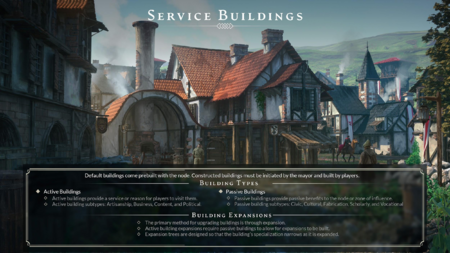
The important thing with the service building system for us is that it's a way to shape your node like a character; and to give you an exclusive niche that you can carve out in the world; or a niche that you fight over. If you go down this weaponsmithing path and you build your node to be this mecca of weaponsmithing and the node three doors down builds it, there's reason for you to conflict over it. They're taking your business. Or maybe you are in a zone and there isn't a weaponsmithing thing anywhere near you, and you do want to start to carve that path for yourself to make your node a place people visit and come to.[164] – Chris Justo
Service buildings within a node are either default buildings that come with the node, or they are constructed buildings, which are initiated by the mayor and built by players.[29][164][165][166][167][168][169] Service buildings are further broken down into two main types:[29][164]
- Active service buildings are service buildings that players directly interact with. These are further broken down into Artisanship, Business, Content, and Political categories.[29][164]
- Passive service buildings provide passive benefits to the node or its zone of influence. These buildings are broken down into Civic, Cultural, Fabrication, Scholarly, and Vocational.[29][164]
- Constructed service buildings are available to every type of node in every location. Where the uniqueness comes in is in some of the default buildings like your node-type building.[170] – Chris Justo
Service buildings are upgraded by expansions, which are unlocked through the placement of passive service buildings.[29][164]
- Building expansions unlock higher tier workstations at the cost of dedicating service building plots.[72][167]
- Node service building expansions specialize the building through a tech tree based on the stage of the node.[171][172]
Service buildings incur a regular maintenance cost of node commodities and gold from the node treasury in order to continue operations.[29][173]
Node layout and style
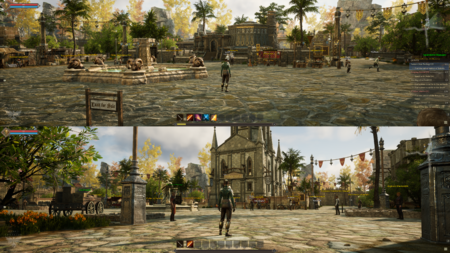
The layout and architecture within a Node’s development area are determined by influential race. For example, a stage 3 Node with the majority of player contribution being Py'rai would have a Py'rai village with Py'rai architecture. Most NPCs would be Py'rai elves, and offer questlines within the Py'rai narrative.[8] – Margaret Krohn
Each player’s contributed experience is flagged with their character race and other identifiers. When a Node advances, the race with the highest experience contribution determines the Node’s style and culture. This style and culture change can happen at every Node Stage. For example, if a Node advances to Level 2 - Encampment Stage and 51% of all experience was earned by Ren’Kai players, the Node will be a Level 2 Ren’Kai Node. If that same Node advances to a Level 3 - Village Stage Node, but the Py'Rai contributed 62% of all the experience earned, then the Node will be a Level 3 Py'Rai Node.[40] – Margaret Krohn
Node layout and style is determined by several factors:[174][175]
- The way that the node system is built is that they can exist across a spread of 18 biomes, but at the same time have to represent the cultural influence of these cultures that are intrinsically a part of a specific biome.[176] – Steven Sharif
- Environment (biome) and location of the node.[176][174][175]
- Nodes will adjust the local topography to fit the aesthetic and mechanical requirements of the node.[177]
- Currently the way that the platform system is set up, is it's capable of adjusting the topography of the node's footprint, regardless of the surrounding terrain. So the reason for that is we want to have flexibility in the presentation of the node's layout and how it is essentially both from an aesthetic standpoint as well as a mechanical standpoint with node sieges- how it's constructed and that construction should have the ability to take on a variance of different types of topography. So it shouldn't be dependent on the surrounding area. Now that's not to say that the surrounding area isn't going to have some influence over. So for example... we're experimenting a little bit with the platform tech and putting up a node up against the side of a mountain or on the edge of a cliff or something that has a beautiful vista. Those are things that we're going to test out obviously as we continue to work on the node tool and how that platform system works, but the idea is to have the node independent of the surrounding terrain.[177] – Steven Sharif
- Some parts are determined by the area it's in. Some parts are determined by the type it is. Some parts are determined by the race it is; and then the rest of it is determined by the mayor.[175] – Jeffrey Bard
- Race that contributed the highest percentage to the node's advancement will alter the racial appearance of its buildings, NPCs, and props.[178][179][174][40][175][180][181]
- All nodes, whether they're associated with a castle or associated with normal node structure, has cultural influences that replicate over to the buildings that are produced and the NPCs that are present.[183] – Steven Sharif
- The rest is determined by the node's mayor.[175]
- It should be possible for a node to complete several building projects within a mayor's one month term in office.[184]
- Q: How long would you say it will take players on average to fill/build up a node completely from wilderness to metropolis?
- A: It's one thing to get a node to a certain level: it's another thing to develop the node; and I can't really give you an on-average expectation, because there's a lot of variables at play. There's how many citizens does the node have attracted to it; what's the type of traffic that the node is attracting to it based on things like its tax rates, or the specialization that it chose to spec into, based on the building types it's chosen to build. All of those things are variables that can affect the quote-unquote "average build-out time" of a particular node. So it's difficult to give you an average when there's so many variables along those lines. But the idea is that if there is a particular project that players are interested in in developing based on the node stage, that they would have the ability to complete several of those projects as within a single term of a mayor; and a term of a mayor is one month.[184] – Steven Sharif
Racial influences

We have essentially sets that exist across all races; and each race that dons those armor sets is going to have their own racial influence on the presentation of those particular sets. So that's something that's unique in how each of the races get diversified. Additionally, the more that one particular race contributes to a node's development, it's going to manifest in that particular node's architectural influences. You're going to see the architectures of those races become manifest within the nodes as well: That's another way that we diversify each race and we present each race's culture in the game as through those architectures, through those props that exist, through the tailoring of the armor sets that the NPC might wear, to the different factions that exist. Factions will have their own affiliation with different races as well. Each race will also have some different nomenclature when it comes to the lore, or comes to locations in the world. They're going to have their own language influences as well: The way they speak is something that's going to be distinct between races; when you have dialogue trees with particular NPCs. So all of those things really go into setting an immersive world where the cultures have their own identity.[178] – Steven Sharif
Cultural influences manifest in many ways, from node and gear aesthetics to NPC languages and lore.[178][186][40]
- Gear appearance of certain armor sets is influenced by the player's race.[178]
- Node layout and style is influenced by the race that contributes the most to that node.[178]
- There is an attrition and that attrition on experience and influence is heightened based on the performance of the race in the world. So if all these nodes are Orc nodes then their attrition rate is very high to compete with the cultural establishment of new nodes because they have more influence in the world and a popular opinion is against them in their outlying regions that they do not have influence in.[187] – Steven Sharif
NPC racial interaction
- NPCs will react differently to different character races.[188]
- Languages will be distinct between NPC races and in the lore.[178]
- Certain quest givers and NPCs may only be present at nodes with certain cultural influences.[189]
- Depending on the cultural influence of the node activates certain types of quest lines and/or sponsors. Some of those are shared, some of those are general. Some of those relate to a progression path that is a first time user experience. Those will be constant across all culture types. Some of them, however, are predicates that spawn when certain story arcs and/or events, or commissions or buy orders become present within the node; and those might change based on the cultural influence of the node. So there is a separation between those populations.[189] – Steven Sharif
Unique node buildings
Each node type has a unique service building associated with it that can be activated at Village (stage 3) of node advancement.[170] The unique building plays a central role in the progress of civilization for a server.[19]
Reliquary
The reliquary is a node building in Ashes of Creation that is used to house relics.[193][194][195]
- Relics stored in a node's reliquary grant passive and active benefits to node citizens and vassal states.[196]
- Benefits will also be conferred to those who capture, steal or sabotage relics held the reliquary.[196]
- Access to the material components of the relics stored in a node's reliquary is granted to registered attackers after successfully destroying that node in a node siege, even though they are not citizens of that node.[194][195]
- When the node is destroyed, the reliquary's contents become available for spoil amongst the attackers; and now even though they weren't citizens might have access to what they wouldn't have access to before, because they weren't a citizen. They'll have access to grab a number of those instances of that material and that's going to be an important aspect because relics are going to be important as part of the whole crafting scheme. So this incentivizes- it acts as an incentive for players to want to engage and battle with these nodes and try to take what they have.[194] – Steven Sharif
Node building destruction
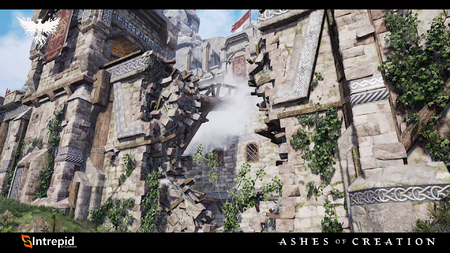
You could be more precision oriented in the decision to attack a city. Let's say it's a rival node that's trying to reach a node stage five or something and you want to disable their ability for the religious system to progress so you target the temple during the attack, or you want to disable their scholars academy from reaching a higher level so that your nodes can; or you want to disable multiple buildings that allow for experience and quests to be undertaken by its citizenship, which prevents them from keeping up in pace of experience gained with your node. These can be more precision oriented and don't have to effectualize an actual takeover of the node.[198] – Steven Sharif
Node buildings (including player housing) have hit points and can be damaged or destroyed by different systems.[172][199]
- NPC-driven events that are a response to story arcs or node atrophy.[172]
- Node sieges and node wars.[172]
- Attackers may not be capable of destroying a node during a siege. Instead they may carry out precision attacks to disable specific service-oriented buildings within the node. These buildings can be targeted with siege weapons and bombs.[198]
- Hazardous events such as tornadoes or hurricanes.[200][172]
- Mayors have the ability to demolish constructed node buildings. This will have a node mandate cost and will require player buy-in via a vote.[29][173]
- Mayors will also have the ability, if they want, to demolish constructed buildings. So if they if they so choose they can destroy a building if they don't think it's needed anymore. But this will have mandate cost and a player buy-in votes. So we want to make sure that [the] mayor can't just go and blow up the whole node if they're trying to grief or something. So this is very important and impactful decision.[29][173] – John Collins
If building maintenance is not paid, or a building is damaged as the result of an event or siege, the building will enter a state of disarray.[29][173] Any NPCs or services offered by that building will not be available until the building is repaired.[166][199]
- Players must contribute materials to repair disarrayed buildings and restore them to an operational state.[29][173][172][199][201]
If a node siege is successful, or if buildings otherwise take significant damage, they are destroyed and appear as rubble on the plot they occupied.[29][173][172]
- Node governments must clear any rubble on plots before any buildings can be reconstructed. Any prerequisites for the building reconstruction must be satisfied beforehand.[172]
- Buildings also live within a prerequisite system. So in order to build down the tech tree of what these buildings provide, as the node grows larger to access stronger building types, you may get a kink in that chain if it's destroyed and you'll have to stand that back up in order to support the service again.[172] – Steven Sharif
- If the node is destroyed by a node siege, the debris field will contain spoils that are lootable by attackers or defenders.[202][203][204][199][205][206]
- Player housing that is destroyed during a node siege can no longer be sold.[207] Furnishing and decorations are retained and can be placed again later.[207][208][209]
Player housing
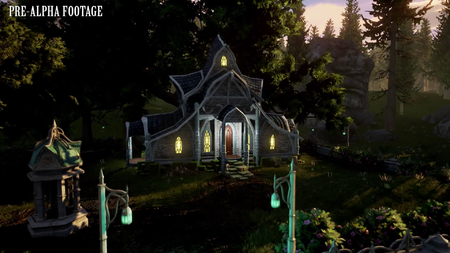
Players will have the ability to survey and develop land anywhere in the world. Be a pioneer deep in the wilderness, build the home of your dreams, and work the land to cultivate resources and supplies. Alternatively, stick with civilization and safety in numbers – purchase a home within the confines of a village and watch your investment grow as that village turns into a city. Homeowners in our game will have the ability to develop their plot of land as they see fit. Focus on farming, animal husbandry, or own your very own smithy. You’ll be able to specialize your land to maximize your profits or your comfort – be sure to choose wisely.[211]
Player housing is player-owned accommodation in the form of Apartments, Freeholds, Inns, and Static housing.[30][15]
A player may own up to one of each type of housing simultaneously.[213][214] Static housing and Apartments are one per server; Freeholds are one per account.[215]
| Player housing | Type. | Availability. | Starting count. | Limit. |
|---|---|---|---|---|
| Apartments | Instanced.[15] | Village stage and higher.[216] | 50.[217] | One per character per server.[215] |
| Freeholds | Open world.[15] | Village stage and higher.[15] | Low thousands per server.[218][219] | One per account.[215] |
| Inns | Instanced.[220] | Starting areas and Nodes.[30] | Most accessible.[30] | - |
| Static housing | In-node.[15] | Village stage and higher.[15] | 8.[217] | One per character per server.[215] |
- If you were to think about the level of exclusivity between the different types of housing that we have, obviously the most exclusive when it comes to a quantity is going to be Freeholds, followed by In-node housing, followed by Apartments, then followed by Inns.[221] – Steven Sharif
Static housing
Static housing provides non-instanced player accommodation within a node, also known as in-node housing.[15]
- Players are able to purchase small one room houses (cottages) starting at the Village (stage 3).[15][217]
- There will be 8 cottages available for purchase at the village stage.[217]
- The amount of static housing increases as a normal part of node advancement.[216]
- The architecture of static housing is predetermined by the racial influence of the node's layout and style.[223]
- Taverns and Player shops are not tied to in-node housing.[224]
Apartments
Apartments provide instanced player housing functionality on a rental basis.[225][15]
- Village (stage 3) apartment buildings offer 50 rental apartments. Additional apartments can be added at Town (stage 4) if the mayor chooses to construct them and if there is an available plot for the expansion. This includes different types of apartments, such as penthouses.[29][30][225][217][15]
- The number and sizes of available apartments increases as a normal part of node advancement.[225][216]
- It is estimated that the number of apartments available in a Metropolis (stage 6) node will be in the hundreds, if that node specs into all apartment expansion upgrades. This number is subject to change based on testing.[225]
- Prices for apartments will fluctuate depending on the number of units already sold in the node.[15]
- Different price points offer different apartment sizes and types, such as penthouses.[30][15]
- It was previously stated that apartments would be available at Town (stage 4) or above.[15]
- The mayor may additionally construct apartment buildings when the node hits stage 4 at one of the building plots in the node, along with cities gaining additional static housing and apartments by default as a normal part of the leveling process.[216] – Steven Sharif
Freeholds

Three main purposes that freeholds provide are allowing players an opportunity to express themselves in a highly customizable fashion. So these are plots of lands that you have access to. You can build different types of buildings on. You can create housing and place furniture; and you can grow livestock and you can just own this piece of land. And one unique thing about allowing the players express themselves through this manner in Ashes of Creation is that it's in the open-world, so it's not an instance or a phase location that you are customizing. You're actually leaving a mark on the world that's representative of you as a player, as a character. Something you can you can roleplay. But importantly enough, when it comes to the economy, freeholds also provide the highest level of processing that's available; and processing is one of three primary branches that exist within the artisanship system. Processing is the intermediary step between what you gather in the wild and what you eventually craft via recipes. The the other primary purpose of freeholds is that they allow you to offer certain types of business services, because we don't just want to make freeholds delegated to the individual owner. We want it to have capabilities to interact with other players as they're walking past your freehold- as they're going to these hunting grounds and participating in quests or events that might be existing around; and that means that location matters for the freehold, because it's important to the business.[227] – Steven Sharif
We got some sheep; we got some cows and pigs; and we got some chickens back there; and we have a lot of space for different farmables. So we have a wheat here, corn, and then tomatoes over there as well.[228] – John Collins
Freeholds are sizable player housing plots that can be situated in baronies within the Zone of influence (ZOI) of a Village (stage 3) or higher node, including the ZOI of any of its vassal nodes.[218][229][230][231][232][233][234][15]
- Freehold estates may be purchased from other players,[235] or can be obtained via deeds from completing a quest and winning an auction.[218][229][230][236][231][232][237][234]
- Freehold ownership, whether purchased from players or via a freehold auction, requires the purchaser to have completed a freehold quest, which has a level requirement of 50.[238][239][218][240]
- The seller decides if their freehold should be auctioned or sold directly to other players.[241]
- Some freehold auctions will require node-type-specific bound currencies, others will auction for gold.[242][243][17] This is intended to cater to players with different playstyles, who are progressing through alternate systems.[242][17]
- The idea is that we're not reserving freeholds for the top 10 percent of levelers, we're reserving freeholds for the top 10 percent across the multiple different play paths that exist within the game; and this spreads out that ownership across different playstyles.[242] – Steven Sharif
- Housing takes several forms in the world of Verra. However, Freeholds are the highest tier of player housing available. Acquiring a Freehold is a major accomplishment, and it will take a large amount of effort and strategy to get a Freehold of your own. Since there is a limited amount of space available to place Freeholds in each node’s region, these are symbols of prestige for those who are able to acquire and maintain their Freeholds.[218]
- Freeholds are approximately 1.5 acres in size, or roughly 100m x 60m.[229]
- The footprint of a freehold does not change with node progression.[244]
- Previously it was stated that freeholds were half an acre in size.[245]
- The developers are expecting the number of freehold plots on each server to be in "the low thousands" depending on world state.[218][219][246][247]
- The number of Freeholds on a server will vary on a number of factors, such as how player actions advance nodes. At the moment we are targeting the low thousands for Freeholds on a server, but as we continue to test these systems during Alpha Two, we anticipate making adjustments.[218]
- Freeholds are subject to node taxes.[130]
- Freehold tax is calculated based on the number of permits issued for buildings on a freehold.[130]
- Freehold buildings that require permits will have additional upkeep costs.[218]
- Blueprints are required for the construction of the freehold buildings that are used to process resources into crafting materials.[248][249][250][251][252]
- The best processing can only be carried out on freeholds, so obtaining a freehold will require a large amount of effort.[253]
- If a player wants to achieve a freehold they can achieve the freehold, however the amount of effort resources and time that's required in order to achieve that freehold is a large amount. It is something that is a monumental achievement for you to to get that freehold; and the reason why is because freeholds tie in very heavily to the processing artisanship aspect. Some processing can be done in nodes, but the best processing is done on freeholds; and we want to make sure that there's a little bit of a throttle or gate on the amount of effort that's necessary to achieve that influence over the processing market.[253] – Steven Sharif
- Inns and other player housing options are available that are easier to obtain for players who do not need the benefits of a freehold.[248]
- Just because the freehold is very difficult to attain doesn't mean that you don't have a space for housing and furniture that you can achieve through our apartment system or an inn or the static in-node housing. Those are alternate methods as well but they do not have that aspect of the best processing is done on the freehold.[248] – Steven Sharif
- Freeholds are intended to work with the family system.[254]
- The spread of corruption in the world does not impact the freehold system.[256]
- Players are not able to adjust the terrain of their freeholds. Sloped terrain will result in stilts beneath placeable structures (to keep them level).[257]
- Expansions and upgrades become available as node progression allows.[245]
Buying and selling (Real estate)
Players buy the deeds for housing from the node itself, or may buy and sell properties from other players.[258][259][260][24][15]
- The developers are considering an auction-based method for listing new properties that become available for purchase when a node advances.[261] Currently freeholds may be acquired via auction.[218][229][230][236][231][232]
- Housing will have a base price that scales with the number of citizens in the node.[262]
- There is no cap on the price of player-originated housing sales.[224]
- In-node housing will be at a premium, and is expected to be hotly contested.[15]
- The more apartments that have been purchased in a node, the higher the price scales.[263]
- Player housing that is destroyed during a node siege can no longer be sold.[207]
- Freehold plots may be purchased from and sold to other players,[258][235] or can be obtained via deeds issued by a Village (stage 3) or higher node.[218][229][230][236][231][232][237][234]
- We're establishing a real estate market that players can invest in and then sell within the in-game economy, but also they are a resource that's subject to removal through the sieging system as well, so there's a bit of risk implied there but the idea is that this is something for players to strive for.[235] – Steven Sharif
- Housing ownership can default back to the node if the owner fails to pay their property taxes. A balance and penalties will be charged to the new purchaser of the home in the manner of a "foreclosure process".[262]
- Players will not be able to exceed their allotment of housing in the game.[266]
- Rental and leasing concepts are under consideration.[266]
Node sieges
As some areas in the world grow, others will fall. This is the foundation of the living, breathing world that is Ashes of Creation, where players will have the ability to make important decisions that matter in the longevity of an area becoming a city, or whether to siege a rival town. Rise above the ashes, create the world around you, and be a part of the story that unfolds because of your actions and decisions.[40] – Margaret Krohn
Node sieges enable players to destroy nodes starting at Village (stage 3).[40] This paves the way for new development and access to the locked content in surrounding nodes. Due to this dynamic, political strife and intrigue play an important role in the structure of the world.[3]
- Sieging nodes will not be an easy task for the attackers. Cities and metropolises will have a considerable defensive advantage.[3]
- There will be systems that mimic some of the mechanics of sieges, but there won't be practice sieges.[268]
- Death penalties do not apply to objective-based events such as node sieges.[269]
- If you own a home in a node and you don't want to see that home destroyed, you need to defend that city![270] – Steven Sharif
- The majority (~80%) of content in Ashes of Creation is open-world but there may be instanced battles within castle and node sieges where specific groups can participate in small, short-duration objective-based battles for specific waypoints.[271]
Node destruction
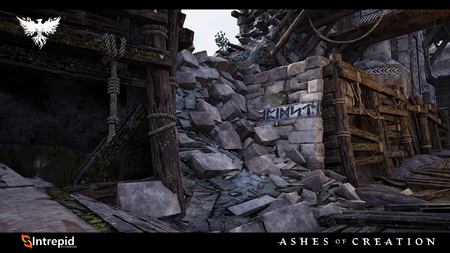
Nodes can be destroyed starting at Level 3 - Village Stage, and are destroyed through sieges. Sieges are started via an item which is acquired through a quest that scales in difficulty with respect to the level of the Node which is being targeted for the siege. Once the item is brought to the Node and is activated, the declaration period begins and a countdown is initiated for players in the region to see. This countdown runs for a number of days equal to the level of the Node being sieged. Once the countdown is complete, the siege begins. There is a cooldown between sieges, and players must wait a certain amount of time after an unsuccessful siege before a new siege can be declared. The higher the Node level, the longer the cooldown between sieges. If a siege is successful, then the Node is brought down to Level 0, and anyone who was a citizen of that Node is no longer a citizen.[40] – Margaret Krohn
Nodes can be destroyed starting at Village (stage 3) following a successful siege against that node.[40]
- It is a normal process of the world to see PvP be a catalyst for change. That is one of the defining elements of our world building approach and being a PvX game is that PvE builds the world and PvP changes the world; and as these nodes get destructed this should be a normal habit that players are accustomed to seeing that landscape changing over time, because it is the breath of renewal that then is allowed as a result of that action.[39] – Steven Sharif
- Players lose their node citizenship after their node is destroyed without entering into a cooldown period.[39][36][40]
- Node destruction may prevent some quests from being completed.[62]
- After a node is destroyed, the footprint of the node will enter a ruined state and will become an open PvP zone for a number of days equal to the node's level. These ruins consist of a debris field of treasures that are lootable by certain players.[202][203][204][199][205][206]
- Which players get to loot the debris field during this period is currently under discussion by the developers.[272] Previously it was stated that any player could loot the debris field.[203] Before that it was stated that only attackers who participated in the siege will have exclusive looting rights.[273]
- Any loot remaining after this period will be open for anyone to loot.[273]
- After a number of days equal to the destroyed node's level, the node will revert back to stage 0 (wilderness) and any modified terrain will revert back to its original state.[203][274][275]
- Those are like open-world battlegrounds that spawn on the footprint of the node after a successful siege. And these are opportunities that previous defenders have to salvage certain materials and/or equipment from the destroyed node, or that attackers have to do the same. And there's interact points that live within that environment that take time in order to interact with, which makes those individuals susceptible to potential ganking or fighting. And you can control those areas; and that exists for some period of time. It's like an open-world arena system.[202] – Steven Sharif
- Treasures in the debris field will take time and tools to uncover.[202][203]
- The warehouse debris will contain a portion of all Materials (crafting components) and Gatherables that were stored in the destroyed node.[203][204][199][205][206]
- The reliquary debris will contain a stockpile of shards of the relics that were stored there.[276][203][204][194][195]
- The town hall debris might contain tax-oriented certificates that were held within the vaults and in the treasury.[204]
- The stables debris might contain mount certificates that can be added to caravans in the future or sold on the auction house.[204]
- Gatherables and crafting materials that were stored in in-node housing and apartment storage chests become lootable. These are not lootable if the node survives the siege- even if the housing buildings are destroyed or damaged during the siege.[199]
Impact on player housing
Player housing designs and decorations are retained and can be placed again later if the housing is destroyed during a node siege.[218][208][209]
- Blueprints for homestead, business, and artisan freehold buildings, including progression and upgrades, are returned to the player.[218][40][208][209]
- A possible design idea is for items such as furnishings to be boxed in crates that are accessible inside the new home.[277]
Impact on in-node housing
Following a node siege, static housing will be scaled back or destroyed based on the advancement of the node.[208]
- If the housing was purchased at a higher advancement than the node currently is then it will be destroyed, otherwise the housing will be scaled back.
Impact on apartments
Apartments may be destroyed in the following circumstances:[208]
- If their building was destroyed during a node siege, even if the siege was not successful.[201][208]
- If the mayor decides to destroy apartment buildings all items and layouts will be mailed to the owner.[278]
- If a mayor built extra apartment buildings at Town (stage 4) or higher and the Node deleveled below that stage.[208]
Impact on freeholds
Freeholds may be attacked by any player for a period of two hours following a successful siege against its parent node.[279][280][40][281] Freeholds can also be lost by foreclosure for not paying property taxes or other fees.[218]
- Players and their allies may defend their freehold for this period of time.[281]
- Structures and guards may be obtained to defend freeholds during this period.[281]
- When it comes to losing Freeholds like this, one person’s loss is another person’s gain. While there aren’t enough Freeholds in the world for everyone to have one at the same time, this cycle of players losing Freeholds creates opportunities for other players to acquire one.[218]
After the two hour period of open combat following a successful node siege, any remaining freeholds will exist under a grace period for roughly 1 week where another node may take over the zone of influence of the freehold.[280][40]
- The freehold owner will be required to undertake a quest process to have their freehold adopted by a new node if one exists.[280]
- At the end of the grace period, if the freehold does not reside within the ZOI of a Village (stage 3) node or above, it will be destroyed.[218][40][280][282]
- If a siege is successful, then the Node is brought down to Level 0, and anyone who was a citizen of that Node is no longer a citizen. Freeholds within the Zone of Influence are subject to a period of vulnerability. These Freeholds can be destroyed by other players during a period of roughly 2 hours after a successful siege. Destroyed Freeholds are subject to material loss, and blueprints for them are mailed to the player to utilize for future placement in order to allow the player to keep their Freehold’s layout and structure. Once the vulnerability period is complete, any remaining Freeholds will exist under a grace period for roughly 1 week where another Node may take over the Zone of Influence of the Freehold.[40] – Margaret Krohn
- Q: How many times a year do you suspect that most players will be moving residence based on nodes being eliminated from sieges?
- A: There are a lot of variables that influence that answer. I'm not sure I can give an average, but what I would say is that depending on the political dynamic of a server: if a server tends to have more combat and/or sieges against nodes, that is going to increase the amount of opportunity for freeholds to be removed from the world and then replaced. I'm not sure I have an average. what I will say is that it is very important to remember that Ashes is not a PvP game and it is not a PvE game. It is a PvX game and that has a very specific meaning. It means that as these systems are developed as they are designed and they are integrated with each other: they are done so from a competitive viewpoint and how that system relates to both PvE and PvP. Freeholds are one of those systems very much so and it's because of the cyclical nature that we're attempting to achieve with the development of nodes and the destruction of nodes, the world is a rapidly and dynamically changing place really. So it's intended to be something that is constantly recycling and is leaking out different types of content and new content that revitalizes the player interest and stimulates new points of conflict or cooperation.[283] – Steven Sharif
Node redevelopment
A node that was successfully destroyed by a node siege may develop differently due to the following influences:[174][284]
- Different races becoming primary contributors.[174][284]
- Design elements determined by different governments.[174][284]
- Reactions and interactions with other nodes in the world.[174][284]
Underrealm nodes
Underrealm nodes and nodes directly above them are considered adjacent but do not exist in the same ZOI.[49][50][51]
- There will be "bleed over" between underrealm nodes and surface nodes in terms of influence and interaction.[50]
- There may be visual cues above ground that indicate influence from underrealm nodes in that area.[50]
That might be a little bit of a departure from our design in the past. I know originally like two-plus years ago we were discussing how those would be independent of each other, but I think as we further defined the layout of the world map itself it made more sense for those to have some interaction and influence that's combined.[50] – Steven Sharif
- Caravan routes will go underground.[285]
- Node sieges occur in the usual manner.[286]
- There will be underrealm Metropolises.[287]
Coastal/island nodes

There will be healthy amounts of sea content within the coastlines of the continents that does not fall into the "open sea" area.[26] – Steven Sharif
There will be nodes along the coast and on islands.[289]
- These nodes will have specific water oriented influences, services, and questlines, that relate to the seas.[289]
- The open sea does not contribute to the advancement of coastal nodes, even if it falls within the ZOI of the node. This is subject to change during Alpha-2 testing.[290]
- Coastal nodes change the spawn tables of the nearby water content and can also trigger specific events.[291]
- Coastal nodes are not directly siegeable by sea. Instead, harbors offer objective-based naval gameplay during node sieges.[292][293][294]
- We've gone back and forth a little bit on whether or not the design intent for sieging of nodes is intended to include, for certain nodes, the naval component. The concern there was that it would be a difficult thing to balance around that particular node having accessibility from the water for those types of defenses. So what we've presented as an opportunity where harbors are the focal point of those naval interactions; and during sieges you are aware that nodes have certain objectives, which have ramifications and can influence the outcome and/or the ongoings of a particular against a node. And if one of those objectives is a naval objective, because that node might own a harbor, which is a point of interest that gets adopted by a node which advances far enough around it. So you might have one harbor and five nodes that can own that harbor. And the first to hit the village stage adopts the harbor. Then that can become an objective point during a siege that has naval interaction. So that's the direction we've moved towards, rather than allowing the naval component to interact directly with sieging the node itself as opposed to being a part of the objective-based gameplay that exists for a node siege.[292] – Steven Sharif
- Island chains are part of Ashes of Creation naval content.[295][296]
Underwater nodes
Underwater points of interest that have NPC structures may appear to be like cities, but they will not be nodes.[297]
- There won't be nodes underwater or in the water.[289]
Patron guilds
Patron guilds unlock the following benefits for their members.[298]
- Emblems can be applied to guild armor that can be purchased from the node.[298]
- Participation in the node's stock market.[298]
- Ability to participate in specific guild-based missions that will progress the guild's leveling and development.[298]
- Allocation of guild points to unlock specific node abilities for guild members.[298]
- Ability to claim an in-node guild hall. These have different perks and benefits to halls placed on freehold plots.[298]
- - Whether an organization is the patron of their node means it contributes the most amount of work to the node from its members.[299]
Any number of guilds can be in a node, but the number of patron guilds within a node is limited by node stage.[300]
- Villages and lower do not have patron guilds.[300]
- Towns can have up to 1 patron guild.[300]
- Cities can have up to 2 patron guilds.[300]
- Metropolises can have up to 3 patron guilds.[300]
Stock exchanges (also called Stock markets and Share markets) enable players to buy and sell shares in Nodes, Guilds and Social organizations.[301][302][303]
- Stock exchanges were a Kickstarter stretch goal unlocked for reaching the $3 million dollar mark.[303]
- This is a planned feature for the launch of Ashes of Creation.[301]
- The value of stocks is influenced by world events and the performance of nodes, Social organizations or guilds.[304]
- Hard metrics, such as quest lines, nearby resources, citizen progression, and purchases of local real estate, will determine the value of purchasable shares.[303]
- There is no regulatory commission to restrict the purchase and sale of stocks.[304]
Visuals
2024-03-03 2023-09-21 2023-09-19 2023-09-13 2023-09-05 2023-09-04 2023-09-04 2023-09-04 2021-09-25 2017-10-24 2017-10-12
Community guides
See also
References
- ↑ X.com - Fly on through the Village Node we showed in our August livestream!
- ↑ 2.0 2.1 2.2 2.3 Node series part I
- ↑ 3.0 3.1 3.2 3.3 3.4 3.5 A reactive world - Nodes.
- ↑ 4.0 4.1 Blog: 10 facts about castle sieges in the MMORPG.
- ↑ 5.0 5.1
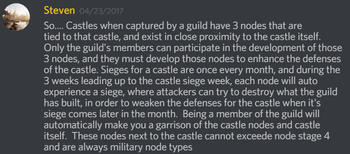
- ↑ 6.0 6.1 Podcast, April 23, 2018 (15:14).
- ↑ 7.0 7.1 Livestream, August 26, 2022 (1:05:47).
- ↑ 8.00 8.01 8.02 8.03 8.04 8.05 8.06 8.07 8.08 8.09 8.10 8.11 8.12 8.13 8.14 8.15 8.16 8.17 8.18 8.19 8.20 8.21 8.22 8.23 8.24 Blog - Know Your Nodes - The Basics.
- ↑ Interview, August 24, 2018 (3:44).
- ↑ Livestream, August 26, 2022 (1:18:54).
- ↑ Livestream, August 26, 2022 (1:06:42).
- ↑ 12.0 12.1 Livestream, November 30, 2020 (37:16).
- ↑ Livestream, October 31, 2023 (1:34:37).
- ↑ Livestream, May 17, 2017 (55:40).
- ↑ 15.00 15.01 15.02 15.03 15.04 15.05 15.06 15.07 15.08 15.09 15.10 15.11 15.12 15.13 15.14 15.15 15.16 15.17 15.18 15.19 Node series part II – the Metropolis.
- ↑ 16.0 16.1 Livestream, May 4, 2017 (15:15).
- ↑ 17.0 17.1 17.2 Interview, July 9, 2023 (19:56).
- ↑ Interview, July 18, 2020 (27:11).
- ↑ 19.0 19.1 19.2 19.3 19.4 19.5 19.6 19.7 19.8 Know Your Nodes: Economic Node Type.
- ↑ 20.0 20.1 Livestream, August 27, 2021 (1:19:43).
- ↑ Blog: Creative Director's Letter
- ↑ Interview, June 13, 2021 (56:35).
- ↑

- ↑ 24.00 24.01 24.02 24.03 24.04 24.05 24.06 24.07 24.08 24.09 24.10 24.11 24.12 24.13 24.14 24.15 MMOGames interview, January 2017
- ↑
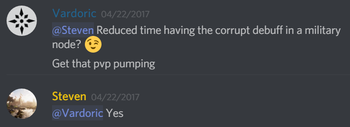
- ↑ 26.0 26.1 26.2 26.3

- ↑ Livestream, May 4, 2018 (51:57).
- ↑ 28.0 28.1 28.2 Blog: Know Your Nodes - Scientific Node Type
- ↑ 29.00 29.01 29.02 29.03 29.04 29.05 29.06 29.07 29.08 29.09 29.10 29.11 29.12 29.13 29.14 29.15 29.16 29.17 29.18 29.19 29.20 29.21 29.22 29.23 29.24 29.25 29.26 29.27 29.28 29.29 29.30 29.31 29.32 Blog: Development Update with Village Node.
- ↑ 30.00 30.01 30.02 30.03 30.04 30.05 30.06 30.07 30.08 30.09 30.10 30.11 30.12 30.13 Livestream, August 31, 2023 (15:51).
- ↑ 31.0 31.1 31.2 31.3 31.4 31.5 31.6 Interview, July 9, 2023 (38:14).
- ↑

- ↑ 33.0 33.1 33.2 Interview, March 27, 2020 (0:30).
- ↑ 34.0 34.1 34.2 34.3 34.4 Video, April 5, 2018 (41:48).
- ↑ Livestream, May 19, 2017 (53:24).
- ↑ 36.0 36.1 36.2 36.3 Interview, July 29, 2020 (17:26).
- ↑ 37.0 37.1 37.2 37.3 37.4 37.5 37.6

- ↑ 38.0 38.1 38.2 38.3 Interview, May 11, 2018 (50:05).
- ↑ 39.0 39.1 39.2 Livestream, August 31, 2023 (20:54).
- ↑ 40.00 40.01 40.02 40.03 40.04 40.05 40.06 40.07 40.08 40.09 40.10 40.11 40.12 40.13 40.14 40.15 40.16 40.17 40.18 40.19 40.20 40.21 40.22 40.23 40.24 Blog - Know Your Nodes - Advance and Destroy.
- ↑ Livestream, August 31, 2023 (2:22:01).
- ↑ 42.0 42.1 Livestream, October 30, 2020 (1:01:00).
- ↑ Livestream, July 9, 2018 (27:12).
- ↑ Livestream, May 26, 2017 (44:52).
- ↑ 45.0 45.1 45.2 45.3 45.4 45.5 45.6 45.7 45.8 45.9 Podcast, September 29, 2021 (4:43).
- ↑ Interview, April 20, 2018 (7:22).
- ↑ Ashes of Creation FAQ.
- ↑ 48.0 48.1 Livestream, July 9, 2018 (39:32).
- ↑ 49.0 49.1 Livestream, March 29, 2019 (58:14).
- ↑ 50.0 50.1 50.2 50.3 50.4 Livestream, March 29, 2019 (29:17).
- ↑ 51.0 51.1 Livestream, May 5, 2017 (37:52).
- ↑ Interview, May 11, 2018 (55:16).
- ↑ 53.00 53.01 53.02 53.03 53.04 53.05 53.06 53.07 53.08 53.09 53.10 Livestream, September 24, 2021 (30:26).
- ↑ 54.0 54.1 Livestream, December 12, 2018 (14:48).
- ↑ Interview, July 20, 2020 (3:45).
- ↑ Video, February 29, 2024 (33:57).
- ↑ Video, April 20, 2017 (0:02).
- ↑
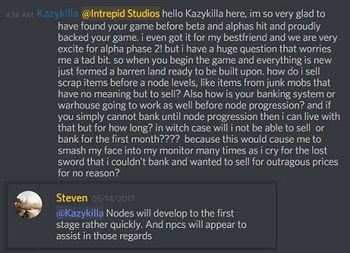
- ↑ 59.0 59.1 Livestream, October 16, 2017 (50:20).
- ↑ 60.0 60.1 60.2

- ↑ 61.0 61.1 61.2 61.3

- ↑ 62.0 62.1 Livestream, February 29, 2024 (53:58).
- ↑ 63.0 63.1 63.2 Interview, July 18, 2020 (10:04).
- ↑ 64.0 64.1 64.2 64.3 64.4 64.5 Interview, July 8, 2020 (1:00:15).
- ↑
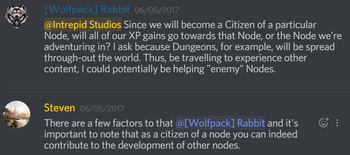
- ↑ Livestream, September 24, 2021 (1:21:23).
- ↑ 67.0 67.1 Livestream, May 26, 2017 (28:16).
- ↑ 68.0 68.1 68.2 68.3 68.4 Livestream, October 14, 2022 (55:13).
- ↑ Livestream, November 17, 2017 (55:27).
- ↑ 70.0 70.1 70.2 70.3 Livestream, August 26, 2022 (1:07:34).
- ↑

- ↑ 72.0 72.1 Livestream, August 31, 2023 (52:56).
- ↑ 73.0 73.1 Livestream, August 26, 2022 (1:04:35).
- ↑ 74.0 74.1 74.2 74.3 74.4 Livestream, August 26, 2022 (1:10:16).
- ↑ Interview, July 19, 2020 (19:35).
- ↑ Livestream, May 15, 2017 (30:53).
- ↑ Livestream, August 26, 2022 (1:28:50).
- ↑ Interview: Ashes of Creation on Building Their Virtual World, 2017-04-13.
- ↑ Interview, July 19, 2020 (1:10:55).
- ↑ Livestream, October 14, 2022 (57:22).
- ↑ 81.0 81.1 81.2 81.3 Interview, July 19, 2020 (1:08:22).
- ↑ Livestream, March 28, 2020 (1:02:46).
- ↑ 83.0 83.1
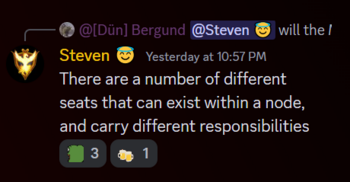
- ↑ 84.0 84.1 84.2 84.3 Livestream, September 29, 2023 (1:07:01).
- ↑ 85.0 85.1 85.2 85.3 Livestream, July 26, 2019 (1:20:48).
- ↑ 86.0 86.1 86.2 Livestream, November 17, 2017 (9:49).
- ↑ 87.0 87.1 Livestream, July 25, 2020 (1:52:45).
- ↑

- ↑ 89.0 89.1 89.2 89.3 89.4 89.5 Livestream, August 31, 2023 (31:44).
- ↑ Livestream, August 31, 2023 (37:35).
- ↑ Livestream, September 29, 2023 (1:05:44).
- ↑ Livestream, March 28, 2020 (1:01:34).
- ↑ 93.0 93.1 93.2 93.3 93.4 Interview, March 27, 2020 (6:03).
- ↑
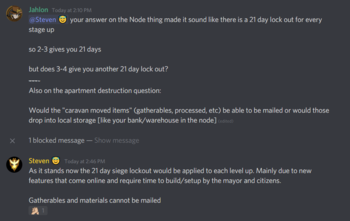
- ↑

- ↑

- ↑ Livestream, August 31, 2023 (59:43).
- ↑ 98.0 98.1 98.2 98.3 Interview, July 8, 2020 (1:04:05).
- ↑ 99.0 99.1 Livestream, June 30, 2017 (53:57).
- ↑ 100.0 100.1 100.2 100.3 100.4 100.5 100.6 100.7 100.8 Livestream, August 31, 2023 (39:17).
- ↑ 101.0 101.1 101.2 101.3 101.4 Livestream, April 29, 2022 (27:42).
- ↑ 102.0 102.1 Livestream, March 28, 2020 (1:03:38).
- ↑ 103.0 103.1

- ↑ 104.0 104.1

- ↑ 105.0 105.1 105.2

- ↑ Livestream, July 25, 2020 (1:22:40).
- ↑ Livestream, January 18, 2018 (37:05).
- ↑
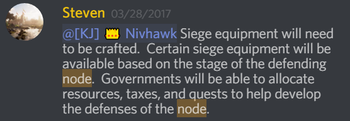
- ↑ Livestream, June 26, 2020 (59:11).
- ↑ 110.0 110.1 110.2 Livestream, August 31, 2023 (35:23).
- ↑ 111.0 111.1 111.2 Livestream, August 31, 2023 (44:21).
- ↑ Livestream, August 26, 2022 (1:12:40).
- ↑ 113.0 113.1 113.2 113.3 City hall.
- ↑ Livestream, August 31, 2023 (29:04).
- ↑ Livestream, August 31, 2023 (30:41).
- ↑

- ↑ Livestream, December 23, 2021 (1:30:34).
- ↑ 118.0 118.1

- ↑ Livestream, August 31, 2023 (41:15).
- ↑ 120.0 120.1 Livestream, August 31, 2023 (28:30).
- ↑

- ↑ 122.0 122.1 Video, September 29, 2023 (1:52).
- ↑ Livestream, August 31, 2023 (29:33).
- ↑

- ↑ Livestream, May 19, 2017 (36:05).
- ↑ Livestream, May 19, 2017 (36:09).
- ↑
- ↑ 128.0 128.1 128.2 128.3 128.4 128.5 128.6 128.7 Video, August 31, 2023 (28:04).
- ↑ Interview, July 9, 2023 (54:46).
- ↑ 130.0 130.1 130.2 Livestream, June 30, 2023 (1:45:22).
- ↑ Livestream, September 29, 2023 (1:11:22).
- ↑ 132.0 132.1 Interview, May 11, 2018 (57:02).
- ↑ 133.0 133.1 Interview, July 19, 2020 (24:34).
- ↑ 134.0 134.1

- ↑ Livestream, May 24, 2017 (40:50).
- ↑ 136.0 136.1 Livestream, June 28, 2019 (1:26:14).
- ↑ 137.0 137.1 137.2 137.3 137.4 Podcast, May 11, 2018 (21:07).
- ↑ Livestream, August 31, 2023 (2:10:23).
- ↑ 139.0 139.1 139.2 139.3 139.4 139.5 Video, February 29, 2024 (2:19).
- ↑ Video, February 29, 2024 (4:18).
- ↑ 141.0 141.1 141.2 141.3 141.4 141.5 141.6 Livestream, February 29, 2024 (57:27).
- ↑

- ↑ 143.0 143.1

- ↑ 144.0 144.1 144.2 144.3 144.4 144.5 144.6 Livestream, August 31, 2023 (42:05).
- ↑ Alpha-1 screenshot.
- ↑ Alpha-1 screenshot.
- ↑ Livestream, May 12, 2017 (42:17).
- ↑ 148.0 148.1 148.2

- ↑ 149.0 149.1 Video, February 29, 2024 (13:11).
- ↑ 150.0 150.1 150.2 Video, February 29, 2024 (5:11).
- ↑ 151.0 151.1

- ↑ 152.0 152.1 Livestream, February 29, 2024 (50:29).
- ↑ 153.0 153.1 Livestream, February 29, 2024 (1:18:21).
- ↑ Video, February 29, 2024 (26:17).
- ↑ Livestream, August 31, 2023 (43:07).
- ↑ Livestream, August 31, 2023 (43:27).
- ↑ 157.0 157.1 157.2 Livestream, August 31, 2023 (1:06:01).
- ↑ 158.0 158.1 158.2 158.3 158.4 158.5 Livestream, December 23, 2021 (1:26:36).
- ↑ Livestream, July 28, 2023 (1:19:55).
- ↑ Livestream, February 24, 2023 (1:22:04).
- ↑

- ↑ Livestream, February 28, 2020 (1:14:38).
- ↑ Livestream, November 17, 2017 (29:45).
- ↑ 164.0 164.1 164.2 164.3 164.4 164.5 164.6 Livestream, August 31, 2023 (50:25).
- ↑ Video, August 31, 2023 (2:59).
- ↑ 166.0 166.1 Interview, July 9, 2023 (1:32:45).
- ↑ 167.0 167.1 Livestream, May 19, 2017 (33:57).
- ↑ Livestream, January 20, 2018 (38:17).
- ↑ Livestream, 2018-04-8 (PM) (51:49).
- ↑ 170.0 170.1 Livestream, August 31, 2023 (56:18).
- ↑ Video, August 31, 2023 (34:37).
- ↑ 172.0 172.1 172.2 172.3 172.4 172.5 172.6 172.7 172.8 Livestream, March 31, 2022 (1:13:00).
- ↑ 173.0 173.1 173.2 173.3 173.4 173.5 Livestream, August 31, 2023 (57:23).
- ↑ 174.0 174.1 174.2 174.3 174.4 174.5 174.6 Livestream, October 30, 2020 (39:17).
- ↑ 175.0 175.1 175.2 175.3 175.4 175.5 Livestream, September 27, 2018 (53:06).
- ↑ 176.0 176.1 Livestream, February 25, 2022 (41:00).
- ↑ 177.0 177.1 Livestream, February 26, 2021 (1:12:18).
- ↑ 178.0 178.1 178.2 178.3 178.4 178.5 Livestream, March 31, 2022 (4:57).
- ↑ Podcast, April 11, 2021 (29:47).
- ↑ Interview, May 11, 2018 (54:34).
- ↑ Livestream, May 26, 2017 (21:23).
- ↑ Podcast, April 11, 2021 (23:36).
- ↑ 183.0 183.1 Interview, May 11, 2018 (47:27).
- ↑ 184.0 184.1 Livestream, July 29, 2022 (1:13:09).
- ↑ Livestream, June 26, 2020 (45:32).
- ↑ 186.0 186.1 Interview, February 7, 2021 (33:00).
- ↑ 187.0 187.1 Interview, May 11, 2018 (1:00:19).
- ↑ 188.0 188.1 Podcast, April 23, 2018 (29:56).
- ↑ 189.0 189.1 Interview, July 9, 2023 (1:35:28).
- ↑ Livestream, September 1, 2018 (36:28).
- ↑ Livestream, May 10, 2017 (28:09).
- ↑ Livestream, May 12, 2017 (49:50).
- ↑ Livestream, April 29, 2022 (21:00).
- ↑ 194.0 194.1 194.2 194.3 Podcast, September 29, 2021 (10:49).
- ↑ 195.0 195.1 195.2 Interview, July 18, 2020 (56:11).
- ↑ 196.0 196.1 Livestream, April 29, 2022 (27:00).
- ↑ Livestream, October 31, 2019 (36:20).
- ↑ 198.0 198.1 Livestream, November 22, 2019 (16:56).
- ↑ 199.0 199.1 199.2 199.3 199.4 199.5 199.6 Interview, July 8, 2020 (57:46).
- ↑ Forums - Livestream Q&A 2022-08-26.
- ↑ 201.0 201.1 Livestream, November 22, 2019 (17:59).
- ↑ 202.0 202.1 202.2 202.3 Interview, July 9, 2023 (1:36:24).
- ↑ 203.0 203.1 203.2 203.3 203.4 203.5 203.6 Livestream, October 14, 2022 (52:31).
- ↑ 204.0 204.1 204.2 204.3 204.4 204.5 Podcast, September 29, 2021 (14:21).
- ↑ 205.0 205.1 205.2 Livestream, April 30, 2020 (1:14:44).
- ↑ 206.0 206.1 206.2

- ↑ 207.0 207.1 207.2 Livestream, June 26, 2020 (1:02:12).
- ↑ 208.0 208.1 208.2 208.3 208.4 208.5 208.6 Livestream, July 18, 2017 (40:14).
- ↑ 209.0 209.1 209.2 Livestream, November 17, 2017 (47:10).
- ↑ Video, May 25, 2017 (1:07).
- ↑ About Ashes of Creation.
- ↑ Livestream, May 4, 2018 (32:46).
- ↑ Interview, July 9, 2023 (42:11).
- ↑

- ↑ 215.0 215.1 215.2 215.3 215.4 Interview, May 11, 2018 (50:47).
- ↑ 216.0 216.1 216.2 216.3 Steven Sharif - Clarification points from today’s stream.
- ↑ 217.0 217.1 217.2 217.3 217.4

- ↑ 218.00 218.01 218.02 218.03 218.04 218.05 218.06 218.07 218.08 218.09 218.10 218.11 218.12 218.13 218.14 218.15 Blog: Exploring the Boundless Opportunities of Freeholds.
- ↑ 219.0 219.1

- ↑ Livestream, August 31, 2023 (22:32).
- ↑ Livestream, August 31, 2023 (18:13).
- ↑ Video, May 31, 2020 (38:50).
- ↑ Livestream, May 19, 2017 (33:57).
- ↑ 224.0 224.1 Interview, July 8, 2020 (33:34).
- ↑ 225.0 225.1 225.2 225.3 Interview, July 9, 2023 (1:50:50).
- ↑ Livestream, May 29, 2020 (36:29).
- ↑ Livestream, June 30, 2023 (9:09).
- ↑ 228.0 228.1 Video, June 30, 2023 (5:41).
- ↑ 229.0 229.1 229.2 229.3 229.4 Livestream, June 30, 2023 (1:12:07).
- ↑ 230.0 230.1 230.2 230.3 Livestream, June 30, 2023 (14:09).
- ↑ 231.0 231.1 231.2 231.3 Development Update with Freehold Preview.
- ↑ 232.0 232.1 232.2 232.3 Video, June 30, 2023 (21:22).
- ↑ Livestream, April 29, 2022 (1:03:44).
- ↑ 234.0 234.1 234.2 Livestream, May 19, 2017 (32:23).
- ↑ 235.0 235.1 235.2 235.3 Livestream, June 30, 2023 (1:15:34).
- ↑ 236.0 236.1 236.2 Livestream, June 30, 2023 (13:10).
- ↑ 237.0 237.1

- ↑ Podcast, July 15, 2023 (11:21).
- ↑

- ↑

- ↑ 241.0 241.1

- ↑ 242.0 242.1 242.2 Podcast, July 15, 2023 (15:14).
- ↑

- ↑ Interview, July 8, 2020 (45:23).
- ↑ 245.0 245.1 Livestream, October 16, 2017 (56:42).
- ↑

- ↑ Livestream, June 30, 2023 (30:21).
- ↑ 248.0 248.1 248.2 Livestream, June 30, 2022 (1:09:29).
- ↑ Livestream, February 25, 2022 (1:12:27).
- ↑ Podcast, April 11, 2021 (40:20).
- ↑ Interview, March 27, 2020 (9:00).
- ↑ Livestream, May 5, 2017 (34:15).
- ↑ 253.0 253.1 Livestream, June 30, 2022 (1:08:02).
- ↑ Livestream, June 30, 2023 (26:23).
- ↑ Livestream, April 7, 2023 (37:56).
- ↑ Interview, July 9, 2023 (49:48).
- ↑ Livestream, January 31, 2024 (1:24:57).
- ↑ 258.0 258.1

- ↑ 259.0 259.1 Livestream, June 26, 2020 (47:32).
- ↑ Livestream, June 26, 2020 (54:03).
- ↑ 261.0 261.1 261.2 261.3 Livestream, May 12, 2017 (55:01).
- ↑ 262.0 262.1 Livestream, June 26, 2020 (53:41).
- ↑ Livestream, May 12, 2017 (52:01).
- ↑ Livestream, June 26, 2020 (56:08).
- ↑ Livestream, June 30, 2023 (1:20:20).
- ↑ 266.0 266.1 Livestream, May 30, 2019 (1:23:41).
- ↑ Video, December 4, 2016 (0:02).
- ↑ Twitch Bustin - Practice Sieges?
- ↑ Livestream, December 22, 2020 (1:13:51).
- ↑ Video, April 30, 2017 (5:31).
- ↑ Livestream, January 28, 2022 (17:50).
- ↑ 272.0 272.1 Livestream, July 28, 2023 (1:26:16).
- ↑ 273.0 273.1 Podcast, September 29, 2021 (15:46).
- ↑ Livestream, June 26, 2020 (1:48:43).
- ↑

- ↑

- ↑ Livestream, June 26, 2020 (1:00:57).
- ↑ Livestream, March 26, 2021 (59:21).
- ↑ Livestream, November 19, 2021 (54:26).
- ↑ 280.0 280.1 280.2 280.3 Livestream, August 28, 2020 (2:04:00).
- ↑ 281.0 281.1 281.2 Livestream, May 19, 2017 (28:04).
- ↑ Livestream, May 19, 2017 (29:34).
- ↑ Livestream, June 30, 2023 (1:39:22).
- ↑ 284.0 284.1 284.2 284.3 Livestream, May 24, 2017 (52:39).
- ↑ Livestream, May 26, 2017 (31:44).
- ↑ Livestream, May 26, 2017 (42:45).
- ↑ Livestream, May 24, 2017 (31:39).
- ↑ Livestream, August 17, 2018 (58:53).
- ↑ 289.0 289.1 289.2 Livestream, 2018-04-8 (PM) (1:01:28).
- ↑ Livestream, March 29, 2024 (2:26:40).
- ↑ Interview, July 19, 2020 (48:05).
- ↑ 292.0 292.1 Interview, July 9, 2023 (1:18:49).
- ↑ Livestream, October 14, 2022 (58:46).
- ↑ Livestream, May 19, 2017 (37:51).
- ↑ Livestream, May 17, 2017 (30:53).
- ↑ Kickstarter - We Just Broke $1,500,000!
- ↑ Livestream, 2018-04-8 (AM) (18:29).
- ↑ 298.0 298.1 298.2 298.3 298.4 298.5 Livestream, February 28, 2020 (1:06:51).
- ↑ Podcast, April 23, 2018 (24:47).
- ↑ 300.0 300.1 300.2 300.3 300.4 Livestream, June 28, 2019 (1:27:23).
- ↑ 301.0 301.1

- ↑ 302.0 302.1 Livestream, May 17, 2017 (11:27).
- ↑ 303.0 303.1 303.2

- ↑ 304.0 304.1 Interview, October 20, 2018 (5:51).

